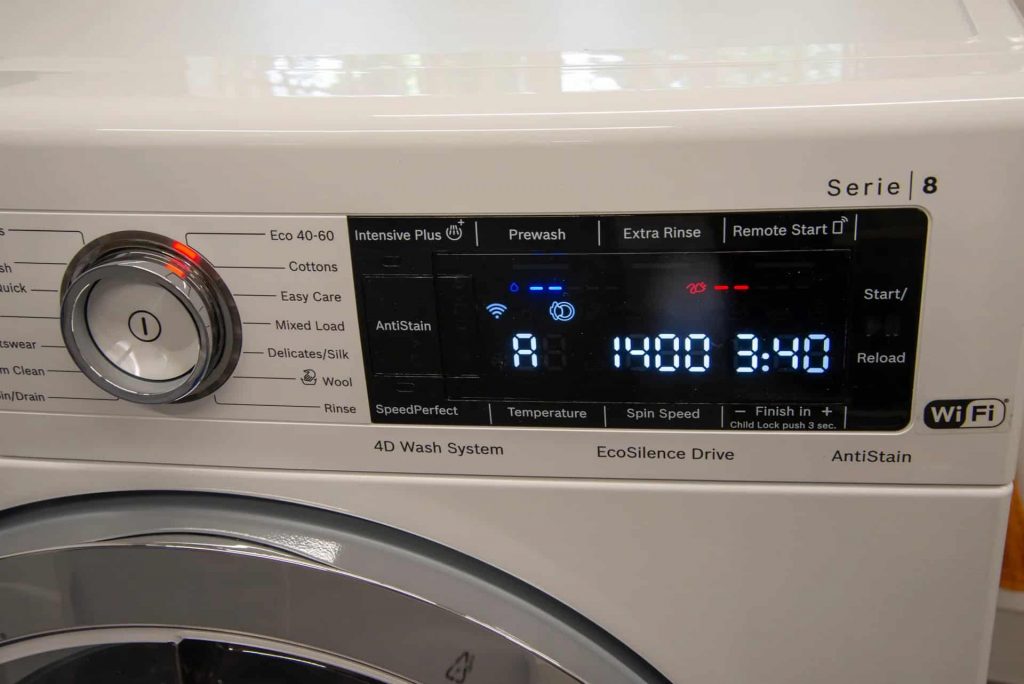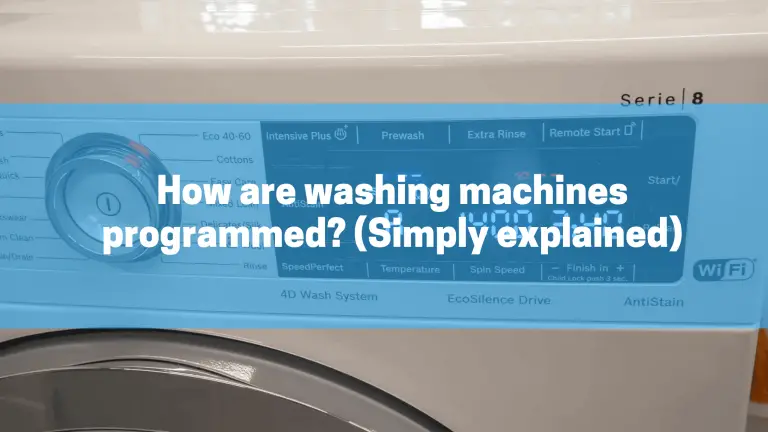Washing machines have come a long way from their mechanical beginnings. Today’s models are highly intelligent, sensor-driven appliances capable of adjusting wash cycles, water levels, spin speeds, and even detergent usage based on the type of load. But have you ever wondered how washing machines are programmed to do all of this?
Here is how washing machines are programmed:
The washing machine contains a microprocessor unit that controls valves, sensors, and actuators that control the various parts of the washing machine through a series of steps to clean your clothes.
In this comprehensive guide, we’ll break down how washing machines are programmed, from the software and control logic to the role of sensors, embedded systems, and user interfaces.
Table of Contents

Understanding the Core Components of a Washing Machine’s Program
Modern washing machines rely on a combination of hardware and software to operate. At the heart of the machine’s behavior is its microcontroller, which runs pre-written programs that manage the sequence of operations based on user input and feedback from sensors.
Here are the main components involved:
- Microcontroller Unit (MCU) – The small computer that stores and runs the washer’s software.
- Control Panel/User Interface – Allows users to select wash settings, cycles, and start/stop commands.
- Embedded Software (Firmware) – Pre-installed instructions and logic that dictate how the washer responds to inputs and sensor data.
- Sensors – Detect water levels, temperature, load weight, motor speed, foam, and door lock status.
- Actuators & Relays – Physically perform tasks like opening the water valve, turning the motor, or spinning the drum.
How Washing Machines Are Programmed (Step-by-Step Overview)
1. Embedded Firmware Development
The logic that controls the washing machine’s behavior is written in low-level programming languages like C or Assembly and is stored in the embedded firmware on the microcontroller. This firmware includes:
- Predefined wash cycles (normal, delicate, heavy-duty, quick wash, etc.)
- Water level and temperature control logic
- Spin speed management
- Error detection (such as unbalanced loads, drain failures, or door lock issues)
- Safety protocols (like stopping the spin if the lid is open)
Firmware engineers develop this logic based on washing machine design specs and test the program on embedded development platforms before flashing it to the washer’s control board.
2. State Machine Logic
Wash cycles are built using a finite state machine (FSM) model. Each cycle consists of a sequence of states (fill, agitate, drain, rinse, spin) that execute based on timing, sensor input, or user overrides.
For example:
- State 1: Fill – Water valve opens until sensor detects desired level.
- State 2: Agitate – Motor turns drum back and forth for a set time.
- State 3: Drain – Drain pump activates, monitored by a water level sensor.
- State 4: Rinse – Clean water added, agitates again.
- State 5: Spin – High-speed motor rotation to extract water.
The MCU transitions between states based on sensor input and timeouts defined in the software.
3. Sensor Feedback and Adaptive Programming
Modern washing machines use real-time sensor feedback to adapt the washing process. Here’s how sensors are programmed to work:
- Load sensors detect weight and adjust water level and cycle duration.
- Temperature sensors ensure water heating is within safe limits.
- Turbidity sensors measure water clarity to determine when rinsing is complete.
- Foam sensors detect excess suds and activate additional rinse cycles.
- Vibration sensors monitor drum balance and reduce spin speed if imbalance is detected.
Programming these sensors involves setting threshold values and conditional triggers in the firmware that alter the washer’s behavior dynamically.
4. User Interface and Customization
The control panel interface is typically a combination of buttons, knobs, LED or LCD displays, and increasingly, touchscreens or smart connectivity.
When a user selects a wash cycle, the input is passed to the microcontroller, which then:
- Loads the corresponding program from memory
- Adjusts parameters (temperature, duration, spin speed) based on user settings
- Initiates the cycle with continuous feedback from sensors
Advanced machines also store custom user profiles, delay starts, and even integrate with mobile apps via Wi-Fi or Bluetooth, requiring additional software modules for communication.
5. Testing and Calibration
Before production, washing machine programs are thoroughly tested and calibrated to ensure consistency. Manufacturers test for:
- Accurate water levels and temperatures
- Timed cycle sequences
- Compatibility with various detergents and fabric types
- Error handling and diagnostic reporting
Some machines also have a diagnostic mode programmed into the firmware that allows technicians to test each component independently (e.g., drum spin test, water valve check, sensor output reading).
Smart Washing Machines and Programmable Logic
In smart washing machines, traditional programming is enhanced with machine learning algorithms, cloud connectivity, and remote firmware updates. These machines may:
- Learn user habits and suggest optimal cycles
- Update firmware over Wi-Fi to improve performance or add new features
- Use AI-based dirt detection and adjust washing time in real time
- Integrate with virtual assistants like Alexa or Google Home
These smart features are programmed using IoT (Internet of Things) frameworks and require more advanced software development environments and security protocols.
Are Washing Machine Programs Customizable by Users?
Most washing machines do not allow users to reprogram the firmware, as it’s embedded and protected. However, some open-source and industrial-grade machines allow access to:
- Custom wash profiles via USB or app
- Advanced configuration settings (spin time, rinse cycles, etc.)
- Debugging and monitoring via service ports
Tinkerers and tech-savvy users sometimes explore microcontroller reflashing or Arduino-based washer mods, but these void warranties and require deep technical knowledge.
Key Technologies Used in Washer Programming
- Microcontrollers (e.g., Atmel, STM32, Microchip PIC)
- RTOS (Real-Time Operating Systems) for managing state transitions
- Sensor fusion algorithms for balancing input from multiple sensors
- EEPROM or Flash memory to store firmware and user preferences
- Wired and wireless communication protocols (UART, I2C, Wi-Fi, Bluetooth)
Do washing machines have software?
Washings machines are run by a system called Soft Real Time Operating System(Soft RTOS).
Generally, a washing machine does not have a traditional operating system like a computer or a smartphone.
Instead, it typically has a control system, often in the form of firmware or embedded software, that is specifically designed to manage and control the various functions of the machine.
This control system manages tasks such as water temperature control, spin speed, and wash cycles, and it also provides the interface for the user to select and adjust various wash settings.
The control system is usually based on microcontrollers or other embedded systems, and it is designed to be highly reliable and efficient.
In some high-end washing machines, the control system may be connected to a network and may have the ability to receive updates or communicate with other devices.
This can provide additional features and capabilities, such as remote monitoring and control, and it can also improve the performance and reliability of the machine.
What programming language does a washing machine use?
Some modern and recent washing machines are run on operating systems such as Tizen (Linux-based).
Older washing machines may run on other software or may be completely electro-mechanically configured.
The programming language used to program a washing machine can vary depending on the manufacturer and the specific model.
However, many modern washing machines are controlled by microcontrollers or embedded systems that use a combination of low-level languages and high-level languages.
Low-level languages, such as Assembly or C, are often used for controlling the hardware components of the machine, such as the motor, sensors, and valves. High-level languages, such as C++ or Python, may be used for implementing the control logic, user interface, and other software features.
In some cases, proprietary programming languages may be used, specifically designed for the control system in a washing machine.
Are washing machines automated?
Washing machines are either fully automated or semi-automated.
A fully automated washing machine controls every aspect involved in washing your clothes. From the time, intensity of washing, checking of water levels, etc.
You just have to put your clothes in and the washer does the rest for you. These fully automated machines are prevalent in America and Europe where water and electricity are readily available.
The semi-automated washing machine is prevalent in parts of the world where water is a bit scarce and electrical currents aren’t as stable and strong.
A semi-automated washing machine requires you to fill up the washbasin yourself and set the machine to start.
Then you need to drain the water after it’s done washing and transfer your clothes to another compartment for spinning.
Read also: Washing machine Air dry
What are washing machine sensors?
Washing machine sensors are the parts of the washing machine that prompt the microprocessor to take various forms of action.
They do this by detecting conditions such as the water level, temperature, movement of the washing machine drum, and even the dampness of clothes to determine how long clothes should be spun to dryness.
These detections are transmitted to the microprocessor so the appropriate next action is taken.
Conclusion
Washing machines are programmed using a sophisticated mix of embedded software, real-time sensor data, and smart logic. The microcontroller serves as the brain, executing pre-coded instructions that manage everything from water level to spin speed to safety shutdowns.
With advances in technology, modern washers are no longer just mechanical devices — they are intelligent appliances that adapt, respond, and even learn. Understanding how these machines are programmed offers insights not only into their functionality but also into the growing role of software in everyday home appliances.
Sources

